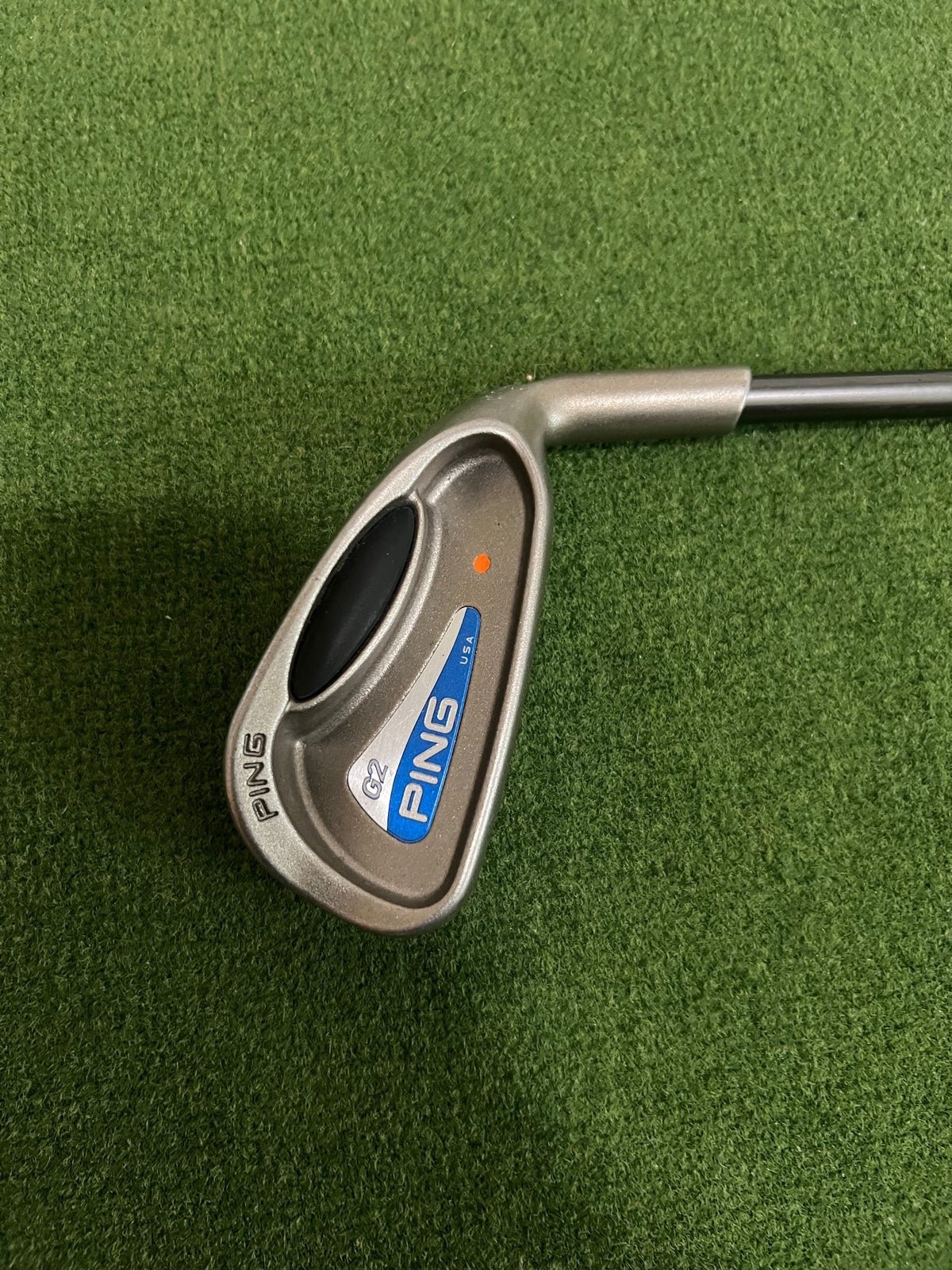Ping I525 Irons

Ping I525 Iron Review
Joel Tadman takes the Ping i525 golf iron out for a spin
If you found this entertaining, you might enjoy
home depot homer award
Although Ping has a longer production cycle than other companies, we had to wait four years before the iron was replaced. It occupies the space between the G425 iron and i210 as a hollow, distance-orientated iron in a slimline chassis. This theme is continued in i525 but Ping asserts that the changes made inside the head will raise the feel, forgiveness, and distance to new heights.
On first inspection, it would appear not much as changed. The only thing that I don’t like about the back is the small textured area. However, it looks almost identical to the i500. This is a good thing considering the aesthetic appeal of the i500, and the fact that it was among the most popular golf irons at the time.
The differences are more apparent when you get down to the address. There are four more grooves on the face of i525 spaced closer together. This is the same as what we saw on the i59 iron, a change designed to reduce fliers from the rough and produce more consistent spin on long iron shots. It is harder to see the white bottom groove due to their thinner structure, making it more challenging for alignment.
The new i525 iron is compared to the i500 at Address
The topline is definitely thinner than on i500 and the hitting area looks a fraction larger while the overall shape looks similar. In short, Ping has made subtle changes while maintaining many of the visual elements that made i500 such a popular compact mid-handicap iron.
The G425 and irons were first tried out at AF Golf Store, Peterborough. I was impressed by the Trackman Launch Monitor data. It indicated that performance had not improved much. The launch speed and ball speed were identical, and the i525 was one yard faster than the i500. The i525 did spin around 300 rpm less, although some of this might have been down to the Project X IO shaft.
Indoor Trackman Launch Monitor Data Testing with Titleist Pro V1x Golf Balls
I then hit shots side by side outdoors and what was immediately obvious was that the i525 did have a more lively, stable feel to it. Although it didn’t feel soft, it felt a bit more lively than the i500.
The shots flew in a similar direction and it was obvious that the i525 took a bit longer to land than the i500, contrary to what our launch monitor said. The i525 shot ended up 3-4 yards higher than the i500. This powerful feeling seems to translate into more yardage.
There were a couple of slight mishits with i525 that carried further than expected, so it looks like your margin for error has increased slightly with i525 but we are only talking fractions. Ping’s problem is that the standard was too high for i500 in looks and performance. However, the i525 improves upon the issues the i500 had with forgiveness and feel of the face. Although the changes are not dramatic, the i525 is immediately a dominant player in compact distance irons alongside the TaylorMade 2021 P790 iron.

It means their first ever hollow body player’s distance iron, the i500, launched in 2018, has unwittingly become the grandfather of player’s distance irons – at four years old, it’s older than any other major iron currently on the market.
Ping had originally planned to unveil the i500 replacement model, the i525, last year. However, delays and shortages forced the launch to be pushed back to 2022. They are fully stocked now and ready to push the new model. This will be their last iron launch of this year.
Let’s take a closer look at the new model.
Cast and forged
Sound and Feel:
Ping have taken the feedback onboard and say strategically positioned EVA polymer inside the i525 creates both the sound and feel that players desire, while also not hindering or slowing face deflection.
There are four more grooves
Like the i59s, the i525s have four more face grooves than the previous model. The idea is tighter grooves and a new groove geometry (with steeper side walls) which reduce the likelihood of fliers from the rough with short irons, while also preserving spin in the long irons for better control, consistency and stopping power.
Weighting of the toes and heels
Because the set is discrete, the weights can be adjusted to custom-build over- or under-length sets. The hollow head has no tuning port like the one in the cavity back.
RELATED: What KBS iron shaft is right for you?
Select your preferred spec
Ping don’t just make their iron sets with just one set of lofts. Every time you buy a Ping iron you can choose to play the standard loft or opt to go 1.5deg stronger (7-iron) with Power Spec, or 2deg weaker with a Retro Spec set-up.
It means you get to choose whether or not you play stronger or weaker loft irons, without having any standard spec forced upon your game.
RELATED: Ping’s G425 performance in the 2022 driver test

Comparison and Review of Ping Irons I525 Irons
The I series of irons from Ping tends to cater more towards low handicap players. The entire family has small, compact heads that have minimal offset. They don’t suit high handicappers.
However, that is not what they were made for. Case in point: the Ping i525 and i210 irons. It was a fascinating juxtaposition, as the Ping i210 irons barely fall within the player’s performance categories. Let’s have a look.

Ping I525
The i525 is a new model for 2022. It targets more distance-orientated players, but still has decent performance. Like all Ping irons, it comes with a hydropearl finish to repel moisture and improve performance in damp grass and wet conditions.
Expect a deep cavity back, more compact head size and less offset in the scoring irons and super playable mid and long irons. They’re a year old, but perfect for club golfers looking for a forgiving and reliable iron that will stand the test of time.
Ping’s hollow body distance iron that targets mid to higher handicap golfers. A black PVD finish disguises the head shape and size beautifully. This brand’s strongest loft will allow you to iron at reasonable speeds.

Review of the Ping Iron I525 Iron: How It Fits into The 2022 Lineup
A brilliant if tiny forged muscleback blade. This blade is for the most skilled and consistent golfers, as well as those who believe they can shot shape their way around the fairway.
If you were a fan of this, you might also appreciate
Ping G425 Irons
Ping launched its excellent hollow-body iron in 2021. This model is for hot-face players. The aluminium core helps to remove weight and tune the sound and feel. It also controls spin consistency and launch.
The i210 was launched in 2018 and is Ping’s most popular tour iron. The model has a traditional perimeter weighted cavity back. Plenty of elastomer tunes sound and feel to the levels requested by the likes of Lee Westwood and Tyrrell Hatton.

Tech
The i525 combines the technologies of i59 irons and G425 irons for improved performance.
-
Maraging Steel Face
A strong, variable-thickness maraging steel allows for a thinner and more dynamic face structure. There is an internal sole undercut which features the 17-4 stainless steel body to increase flexion and this launches shots faster and higher.
You can also see the face in G425 irons. It produces the trampoline-like bounce of the ball leaving your face at a rapid pace.
-
Sound and Feel:
The sound can be more hollow if the face is moving, which could lead to a more pronounced sound. To counteract this Ping has created an EVA polymer that cushions impact sound and feels while still allowing maximum facial deflection.
Hydropearl 2.0 Chrome finish is available. This chrome finish repels water and allows for greater spin in wet conditions. This finish also features on i59 and G425 irons and more recent Glide wedges.
-
Micromax grooves
The groove pattern is precision-milled and has four additional grooves. This reduces fliers in short irons and maintains spin levels for long irons.
-
Extreme weighting
Tungsten weights in the toe and shaft tip are separated across the head to maximise stability, which leads to increased ball speed and less face rotation to help accuracy.
You can watch my full review via the Golfalot YouTube channel here:
If you like what you see, please make sure you SUBSCRIBE to our YouTube channel to see all Golfalot video reviews and features first.

Outdoor Performance
I couldn’t wait to get these irons out on to the golf course and test them in a number of different scenarios, from the centre of the fairway to approaches from the rough.
Out on the course the ball seemed to launch really high from just an average shot which I didn’t really see whilst hitting from a mat on the range. This is a positive as I felt my launch was a touch low during initial testing with the Flightscope Mevo+.
The irons were very easy to shape both ways and also flight down if necessary, and they really fitted well into the ‘younger brother’ role in the players distance iron category.
The scenario that I really wanted to test was the flier lie in the rough, compared to the poor lie in the rough.
It was wet and juicy grass and I opted for an 8 iron from 125 yards. The shots were very similar, with the slight left flag. The shot from the worse lie had a slightly lower flight and both landed within a yard of each other on the green. This is fantastic consistency from the same club and same yardage, but with a totally different lie.
Ping appears to have addressed the problem of flyers that I observed in the i500 irons, but not losing the ability to move the ball away from a sticky lie.
If you were a fan of this, you might also be into
lowes attendance policy
These clubs are much easier to hit than an i59 iron which was highlighted with the shots from the rough and also when I went on to hit the 4 iron from the fairway.
The first shot was sharp, and it fizzed through air. It flew 160 yards before stopping at pin-high. My second shot was a poor heavy strike which came out lower, but the ball still managed to chase up and on to the green.
After playing a few holes with these irons, the biggest compliment I can give them is that I wanted to carry on. It was mid-winter in Manchester, which is a good sign.

Specifications

Who is it aimed at?
These irons are similar in performance to the likes of the Mizuno Pro 225, TaylorMade P790 and Callaway Apex Pro irons, but they are PS30 more per club and I can’t tell you why.
These amateur golfers are not great at flushing the ball, but they can hit the ball quite well most of the times. I doubt you’ll see these irons on the men’s tours but I think you will on the women’s.
I would suggest that anyone below an 18 handicap could use these irons and certainly a single figure golfer.
These irons are very well made and will look fantastic in any bag. However, you’ll need some cash to buy them.



















/cdn.vox-cdn.com/uploads/chorus_asset/file/23133262/1235479424.jpg)
